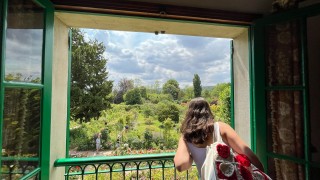"I wanted to experience the city not just as a tourist, but as an artist-in-residence, to see if the freedom my predecessors spoke of was tangible."
The light in Paris is different.
It’s a quality artists have tried to capture for centuries, a soft, diffused glow that seems to gild the limestone buildings and dance on the Seine. For me, standing in the Louvre, sketchbook in hand, that light felt like an inheritance. It was the same light that fell upon the canvases of the great Western Art masters and, crucially, upon the faces of the Black American artists, writers, and musicians who found refuge in this city generations before me. My study abroad experience, generously supported by the Global Learning Scholarship, was not merely an academic semester— it was a pilgrimage. It was a journey to understand why Paris has historically functioned as a sanctuary for Black artists, to walk in their footsteps with my children by my side, and to deepen the intellectual foundations of my own work as a filmmaker.
The Global Learning Scholarship was a critical catalyst that made this profound journey possible. As a mother who forged a new path for myself and my children after leaving an abusive marriage, the financial and institutional support from the GLS and the Center for Undergraduate Global Education was more than just funding; it was an affirmation.
It affirmed that the pursuit of higher education and global engagement is not a solitary or selfish endeavor but can be a family one. The scholarship allowed me to provide my children with an immersive, enriching experience abroad, turning what could have been a singular academic pursuit into a shared family experience. Watching them navigate the Fountainebleu, bravely practice the French language, and develop a palate for—and a critical perspective on, the city’s famed patisseries and baguettes, was a core part of my story. The GLS supported not just a student, but a family, enabling us to collectively benefit from the culture and landscape.
Academically and professionally, my time in Paris was transformative. My coursework focused on 19th-Century Art History and the African Diaspora in France, disciplines I approached not as separate fields but as intertwined narratives. In the halls of the Louvre, my children and I undertook the traditional practice of copying masterworks, a technique central to the Académie des Beaux-Arts. As my hand sketched the lines of a David or a Delacroix, my mind was critically engaged with a different set of questions: Who was excluded from this canon? What stories were left untold on these vast canvases that often romanticized colonial power? This practice was deeply personal.
There was a time when my ancestors were legally forbidden from literacy, let alone afforded the opportunity to study art in Europe. My opportunity was an act of reclaiming a space from which we had been historically barred.
This academic work directly fuels my career goals as a filmmaker. My research into the Great Migration revealed that it was not merely a movement north within the United States but a global dispersal. Writer’s like James Baldwin and Richard Wright migrated to Paris to escape the brutal confines of America’s Jim Crow, seeking the intellectual and creative freedom the city promised. Walking the same streets of Montmartre and Saint-Germain-des-Prés where they lived, worked, and debated, I was walking in the path of those seeking truth. Their legacy is not one of simple escape, but of strategic refuge—to create groundbreaking work that would eventually force a reckoning back home. This is the core of my filmmaking: to find those untold and silenced stories, to give them visual and narrative form.
And to explore the complex spaces that have served as both a backdrop and an active character in the Black diasporic experience.
My reason for studying abroad was rooted in this need to understand the allure of Parisian refuge firsthand. I wanted to experience the city not just as a tourist, but as an artist-in-residence, to see if the freedom my predecessors spoke of was tangible. The answer was complex. My experience was overwhelmingly one of love and joy. There was immense pleasure in becoming a flâneuse, wandering with my children, discovering hidden courtyards, and indulging in a fraiser or pain au chocolat from a different patisserie on every block. Yet, this joy existed alongside a constant, critical interrogation. How does one reconcile the sublime beauty of French art and culture with the nation’s deep complicity in colonialism and the sugar trade that built its wealth? The very pastries we enjoyed were a product of a globalized system born of immense suffering.
I learned that this duality is the heart of the modern Black experience globally. It is a place of incredible possibility and profound contradiction. One can feel both liberation from certain American racial paradigms and encounter new, nuanced forms of otherness. This critical engagement holding both beauty and historical burden in my mind—is not a source of guilt, but of depth.
My summer in Paris, supported by the Global Learning Scholarship, was a chapter of immense growth.
It allowed me to be a student, a mother, an artist, and a critic simultaneously. It provided the historical context and personal inspiration to solidify my academic focus and my cinematic mission.
I returned to Columbia/New York not only with pages of a research paper and a portfolio of sketches but with a renewed conviction to tell stories that are global in scope, critical in nature, and deeply human in their essence. I am forever grateful for the opportunity to have followed in the footsteps of the profound, and now, more than ever, I am prepared to carve a path of my own in the light.

